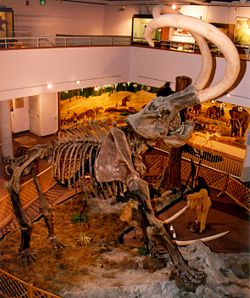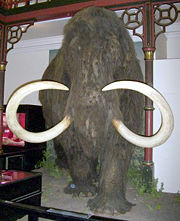Mammoth
| Mammoth Fossil range: Early Pliocene to Holocene |
||||||||||||
|---|---|---|---|---|---|---|---|---|---|---|---|---|
 Mount of a Columbian Mammoth
|
||||||||||||
| Scientific classification | ||||||||||||
|
||||||||||||
| Species | ||||||||||||
|
A mammoth is any species of the extinct genus Mammuthus. These proboscideans are members of the elephant family and close relatives of modern elephants. They were often equipped with long curved tusks and, in northern species, a covering of long hair. They lived from the Pliocene epoch from 4.8 million years ago to around 4,500 years ago.[1][2] The word mammoth comes from the Russian мамонт mamont, probably in turn from the Vogul (Mansi) language.[3]
Contents |
Extinction
The woolly mammoth was the last species of the genus. Most populations of the woolly mammoth in North America and Eurasia died out at the end of the last Ice Age. Until recently, it was generally assumed that the last woolly mammoths vanished from Europe and Southern Siberia about 10,000 BC, but new findings show that some were still present there about 8,000 BC. Only slightly later, the woolly mammoths also disappeared from continental Northern Siberia.[4] Woolly mammoths as well as Columbian mammoths disappeared from the North American continent at the end of the ice age. A small population survived on St. Paul Island, Alaska, up until 3,750 BC,[5][6][2] and the small mammoths of Wrangel Island survived until 1,650 B.C.[7][8][9]
A definitive explanation for their mass extinction is yet to be agreed upon. About 12,000 years ago, warmer, wetter weather began to take hold. Rising sea levels swamped the coastal regions. Forests replaced open woodlands and grasslands across the continent. The Ice Age was ebbing. As their habitats disappeared, so did the bison and the mammoth.
Whether the general mammoth population died out for climatic reasons or due to overhunting by humans is controversial. Another theory suggests that mammoths may have fallen victim to an infectious disease. A combination of climate change and hunting by humans is the most likely explanation for their extinction.
New data derived from studies done on living elephants (see Levy 2006) suggests that though human hunting may not have been the primary cause for the mammoth's final extinction, human hunting was likely a strong contributing factor. Homo erectus is known to have consumed mammoth meat as early as 1.8 million years ago (Levy 2006: 295).
However, the American Institute of Biological Sciences also notes that bones of dead elephants, left on the ground and subsequently trampled by other elephants, tend to bear marks resembling butchery marks, which have previously been misinterpreted as such by archaeologists.
The survival of the dwarf mammoths on Russia's Wrangel Island was because the island was very remote and uninhabited in the early Holocene period. The actual island was not discovered by modern civilization until the 1820s by American whalers. A similar dwarfing occurred with the Pygmy Mammoth on the outer Channel Islands of California, but at an earlier period. Those animals were very likely killed by early Paleo-Native Americans, and habitat loss caused by a rising sea level that split the Santa Rosae into the outer Channel Islands.
Thomas Jefferson, well-versed in the natural sciences, suggested to Lewis and Clark that they might find mammoth fossils during their explorations of the American West.
Size

Like their modern relative the elephant, mammoths were quite large; in English the noun "mammoth" has become an adjective meaning "huge" or "massive". The largest known species, the Imperial Mammoth of California, reached heights of at least 5 meters (16 feet) at the shoulder. Mammoths would probably normally weigh in the region of 6 to 8 tonnes, but exceptionally large males may have exceeded 12 tonnes. An 11-foot (3.4 m) long mammoth tusk was discovered north of Lincoln, Illinois in 2005.[10] However, most species of mammoth were only about as large as a modern Asian Elephant. Fossils of species of dwarf mammoth have been found on the Californian Channel Islands (Mammuthus exilis) and the Mediterranean island of Sardinia (Mammuthus lamarmorae). There was also a race of dwarf woolly mammoths on Wrangel Island, north of Siberia, within the Arctic Circle.
Based on studies of their close relatives the modern elephants, mammoths probably had a gestation period of 22 months, resulting in a single calf being born. Their social structure was probably the same as that of African and Asian elephants, with females living in herds headed by a matriarch, whilst bulls lived solitary lives or formed loose groups after sexual maturity.
Well preserved specimens
In May 2007, the carcass of a six-month-old female woolly mammoth calf was discovered in a layer of permafrost near the Yuribei River in Russia, where it had been buried for 37,000 years. Alexei Tikhonov, the Russian Academy of Science's Zoological Institute's deputy director, has dismissed the prospect of cloning the animal, as the whole cells required for cloning would have burst under the freezing conditions. Nonetheless, DNA is expected to be well enough preserved to be useful for research on mammoth phylogeny and perhaps physiology.[11][12] However Dr Sayaka Wakayama from the RIKEN Center for Developmental Biology in Kobe, Japan, believes that a technique he has used to clone mice from specimens frozen for sixteen years could be used successfully on recovered mammoth tissue: he argues that in his experiments the dead mice had been frozen to -20°C under simulated natural conditions, without using the usual preservative chemicals.[13]
Researchers have sequenced about 80% of the gene map of the woolly mammoth, using DNA taken from hair samples collected from a selection of specimens, advancing the possibility of bringing the woolly mammoth back to life by inserting mammoth DNA sequences into the genome of the modern-day elephant. Although the samples were washed with bleach to remove possible contamination from bacteria or fungi, some DNA bases identified may be from the contaminating organisms and these have yet to be distinguished, by comparison with the genome of the African elephant currently being generated by scientists at the Broad Institute.[14][15][16] The information cannot be used to synthesize the mammoth DNA, but Dr Stephan Schuster, leader of the project at Penn State University, notes that the mammoth’s genes differ at only some 400,000 sites from the genome of the African elephant and it would be possible to modify an elephant cell at these sites to make it resemble one bearing a mammoth's genome, and implant it into a surrogate elephant mother.[17]
See also
- Elephant
- Mastodon
- Pleistocene Park
- La Brea Tar Pits - cluster of tar pits located in California, USA
References
- Capelli, Cristian; MacPhee, Ross D.E.; Roca, Alfred L.; Brisighelli, Francesca; Georgiadis, Nicholase; O'Brien, Stephen J.; Greenwood, Alex D. (2006): A nuclear DNA phylogeny of the woolly mammoth (Mammuthus primigenius). Molecular Phylogenetics and Evolution 40 (2) 620–627. doi:10.1016/j.ympev.2006.03.015 (HTML abstract). Supplemental data available to subscribers.
- Levy, Sharon (2006): Clashing with Titans. BioScience 56(4): 292-298. DOI:10.1641/0006-3568(2006)56[292:CWT]2.0.CO;2 PDF fulltext
- Lister, Adrian & Bahn, Paul (1994): Mammoths. MacMillan, London. ISBN 0-02-572985-3
- Martin, Paul S. (2005): Twilight of the mammoths: Ice Age extinctions and the rewilding of America. University of California Press, Berkeley. ISBN 0-520-23141-4
- Mercer, H.C. (1885): The Lenape Stone or The Indian and the Mammoth. DjVu fulltext PDF fulltext
- Stone, Richard (2001): Mammoth: The resurrection of an Ice Age giant. Fourth Estate, London. ISBN 1-84115-518-7
Footnotes
- ↑ "Woolly Mammoth (Mammuthus primigenius)". Academy of Natural Sciences. Retrieved on 2007-07-20.
- ↑ 2.0 2.1 Schirber, Michael. "Surviving Extinction: Where Woolly Mammoths Endured". Live Science. Imaginova Cororporation. Retrieved on 2007-07-20.
- ↑ Oxford English Dictionary:Mammoth (2000).
- ↑ Anthony J. Stuart, Leopold D. Sulerzhitsky, Lyobov A. Orlova, Yaroslav V. Kuzmin and Adrian M. Lister: The latest woolly mammoths (Mammuthus primigenius Blumenbach) in Europe and Asia: a review of the current evidence Quaternary Science Reviews Volume 21, Issues 14-15, August 2002, Pages 1559-1569online
- ↑ Kristine J. Crossen, “5,700-Year-Old Mammoth Remains from the Pribilof Islands, Alaska: Last Outpost of North America Megafauna”, Geological Society of America Abstracts with Programs, Volume 37, Number 7, (Geological Society of America, 2005), 463.
- ↑ David R. Yesner, Douglas W. Veltre, Kristine J. Crossen, and Russell W. Graham, “5,700-year-old Mammoth Remains from Qagnax Cave, Pribilof Islands, Alaska”, Second World of Elephants Congress, (Hot Springs: Mammoth Site, 2005), 200-203
- ↑ Kh. A. Arslanov, G. T. Cook, Steinar Gulliksen, D.D. Harkness, Touvi Kankainen, E. M. Scott, Sergey Vartanyan, and Ganna I. Zaitseva, S. L. Vartanyan, “Consensus Dating of Remains from Wrangel Island”, Radiocarbon, Volume 40, Number 1, (Tucson: Radiocarbon, 1998), 289-294.
- ↑ Sergei L. Vartanyan, Alexei N. Tikhonov, and Lyobov A. Orlova, “The Dynamic of Mammoth Distribution in the Last Refugia in Beringia”, Second World of Elephants Congress, (Hot Springs: Mammoth Site, 2005), 195.
- ↑ Vartanyan, S.L.; Kh. A. Arslanov; T. V. Tertychnaya; S. B. Chernov (1995). "Radiocarbon Dating Evidence for Mammoths on Wrangel Island, Arctic Ocean, until 2000 BC". Radiocarbon (Department of Geosciences, The University of Arizona) 37 (1): pp 1–6. http://packrat.aml.arizona.edu/Journal/v37n1/vartanyan.html. Retrieved on 2008-01-10.
- ↑ Recently discovered long Woolly Mammoth tusk on display at the Illinois State Museum Illinois Department of Natural Resources press release, August 14, 2006
- ↑ Rincon, Paul (2007-07-10). "Baby mammoth discovery unveiled", news.bbc.co.uk, The BBC. Retrieved on 2007-07-13.
- ↑ Solovyov, Dmitry (2007-07-11). "Baby mammoth find promises breakthrough", reuters.com, Reuters. Retrieved on 2007-07-13.
- ↑ Wakayama, Sayaka; et al (3 November 2008). "Production of healthy cloned mice from bodies frozen at −20°C for 16 years". PNAS (Washington, DC: The National Academy of Sciences of the USA). doi:. http://www.pnas.org/content/early/2008/10/31/0806166105. Retrieved on 7 November 2008.
- ↑ Staff (19 November 2008). "Scientists sequence woolly-mammoth genome". Penn State Live. Penn State University. Retrieved on 25 November 2008.
- ↑ Fox, Maggie (19 November 2008). "Mammoth genome sequence may explain extinction", Reuters. Retrieved on 20 November 2008.
- ↑ Gilbert, Thomas P.; et al (28 September 2007). "Whole-Genome Shotgun Sequencing of Mitochondria from Ancient Hair Shafts". Science (Washington DC: American Association for the Advancement of Science) 317: pp 1927-1930. doi:. ISSN 1095-9203. http://rw.mammoth.psu.edu/pubs/hair.pdf. Retrieved on 25 November 2008.
- ↑ Wade, Nicholas (19 November 2008). "Regenerating a Mammoth for $10 Million", New York Times. Retrieved on 25 November 2008.
External links
- "Mammoth find. New evidence links Siberian, North American mammals", Little Mammoth from North America found in Siberia, in Canada National Post, September 05, 2008.
- "The Mammoth Story" by Grant Keddie - an article on the Royal British Columbia Museum website
- Mammoth Site of Hot Springs, South Dakota
- "The Great Mammoth Hoax"
- BBC: Mammoth skeleton found in Siberia
- "Back from the dead": A feature on efforts to clone mammoths back from extinction, Cosmos Magazine, 6 December 2006.
- Humans not responsible for mammoth extinction
- The Waco Mammoth Site
- Wenas Creek Mammoth Site The Wenas Creek Mammoth Project is a Central Washington University (CWU) scientific investigation of mammoth bones found on private land in the Wenas Creek Valley near Selah, Washington
- Western Center for Archaeology and Paleontology Hemet, California
- Mammoth Genome Cracked: Key to Cloning? in Cosmos Online.
